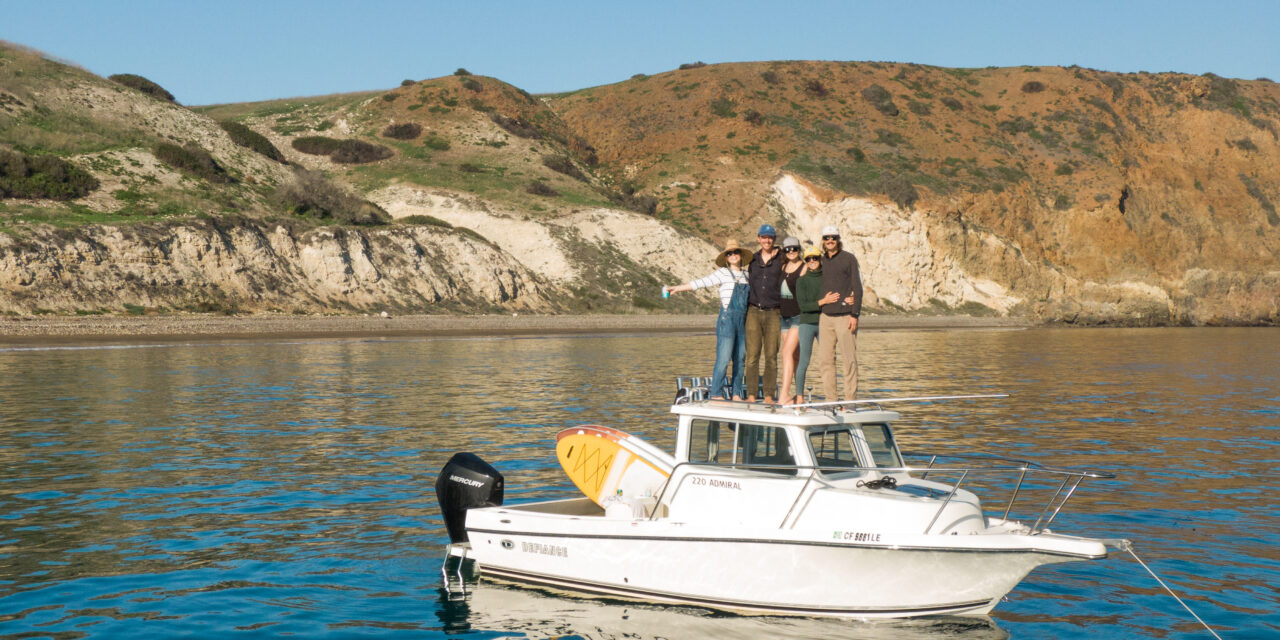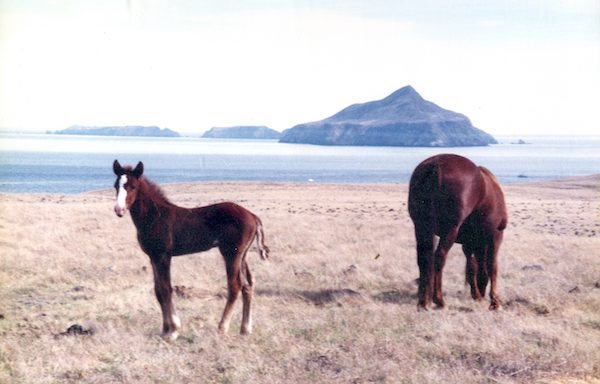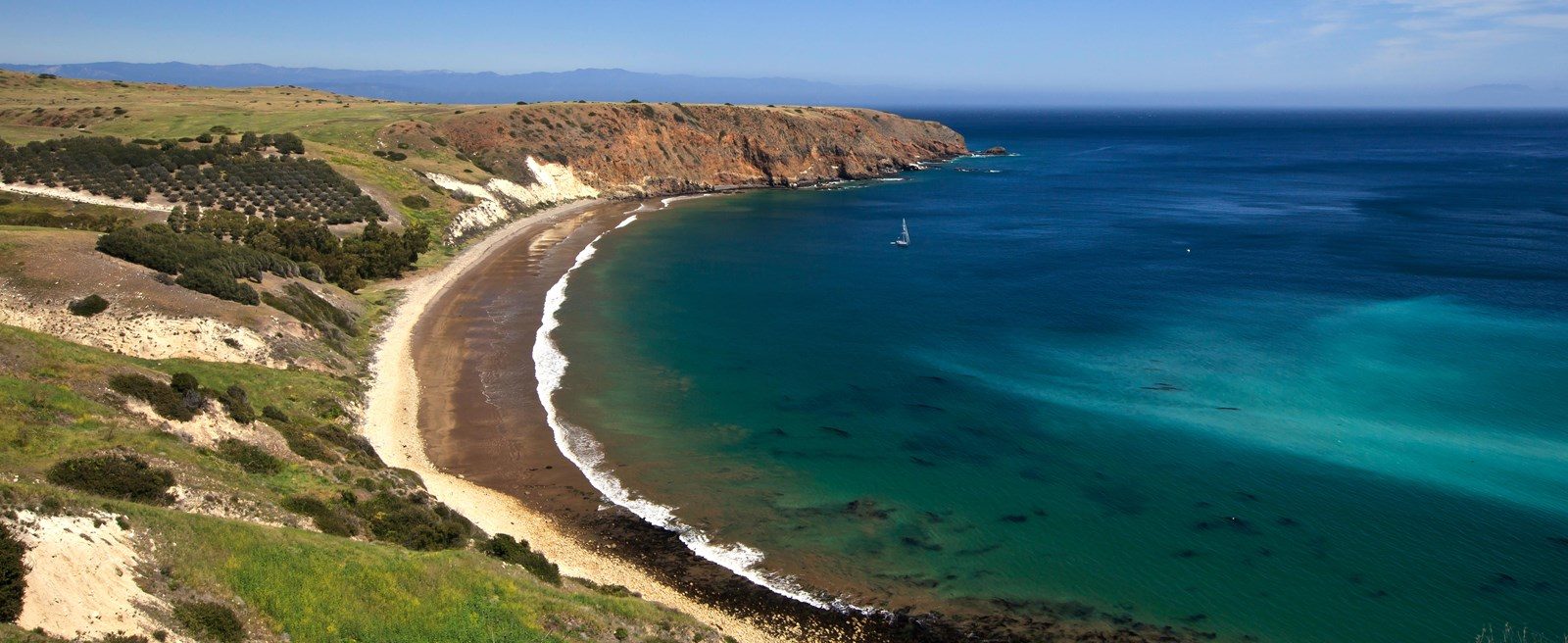- Isla San Francisco - 04/29/2024
- Sailing: How To Catch Wind - 07/03/2023
- Biking Angel Island - 11/29/2022
Discovering Historical Treasure on Santa Cruz Island
By: Marissa Neely
As liveaboards and avid sailors, it pains me to say that our last sail aboard our boat, Avocet, was in October of 2021 – but it’s not for a lack of wanting. My partner Chris and I have been keeping busy with various boat projects from refinishing our cabin sole to building a hardtop dodger in addition to working to fund the projects; our final big push before we cast off for good in search of adventure beyond the horizon. Despite the projects and lack of sailing, we do our best to find the time to put away the tools and get out on the water with our friends however we can… even if that means using a powerboat *shutter*.
Yes, a powerboat — a sailors arch-nemesis, nicknamed “stink pots” due to their gas-guzzling nature. Although we much prefer the serenity sailing brings, we must admit that it was nice to be able to jet out to Santa Cruz Island from Ventura and return to the harbor before sundown all in the same day.
Santa Cruz Island is the largest of the 8 Channel Islands off the coast of southern California and holds a lot of historical significance while remaining unplugged from the mainland. There are no towns, hotels, or current inhabitants, leaving this land 100% natural besides the few remnants of a time long ago when the island was a ranch operation. We will get to that later …
Since we were not investing in a comfortable anchorage to spend the night in, we had the opportunity to check out some of the less comfortable spots around the island including Smugglers Cove, a place we had never had a good night of rest or the ability to get to shore.
Smugglers Cove is located to the south of the island’s easternmost point, San Pedro Point. The anchorage provides good holding in northwesterly winds, and despite our personal experiences, it remains a favorite for visiting boats during the summer and fall months. Despite its good anchor grounds, going to shore is particularly difficult due to the common presence of an inside swell.
Using our new blow-up paddleboards we made landfall and quickly took to combing the beach. The rocky shoreline was speckled with shells, fossils, and whole bones … ultimately leading me to the motherload — A skull perched beautifully atop a collection of bird, pinniped, and small mammal bones. This skull was very unusual for the island, as it was nearly triple the size of the island’s largest mammal, the island fox. After gentle analysis and observation, it appeared to be a cow skull – but unlike any cow skull I have ever seen before. We took photos then left the skull behind, despite how badly I wanted to take it home.
As we continued down the shoreline we investigated a pile of weathered wood. As we approached, the wooden shape unveiled more of itself and it didn’t take long for us to realize that we were looking at the “bones” of an old boat! The crossbeams jetted out of the rocks like a rib cage, with bronze bolts, mounts, conduit, and other machinery scattered around the surrounding area.
We carefully climbed “aboard” to see if there was any defining clue as to what vessel we were looking at, but unfortunately, there were no true tells and we realized we would have to research it later. We gathered as many photos and videos as we could to help us in our investigation before waving the remnants goodbye and rejoining our friends on the boat.
Some of us in the water and some atop the boat, we lounged around enjoying the sunshine and cool blue ocean. Although the moments of peace were comforting and very much so needed, it was all disrupted when we witnessed something truly horrific take place onshore. From the boat, we watched two park rangers ride down the trail in a 4×4, quickly jumping out to walk the shoreline. They immediately gathered around the bone pile we were admiring earlier and began throwing the remains across the beach in an attempt to dismantle the man-made structure.
Although the bones being scattered is better for the ecosystem, the way they were throwing the bones and laughing did not sit well with me. To my horror, I watched one of the women pick up the beautiful intact skull that I had been admiring hours prior, and throw it across the beach where it bounced then shattered. My soul was as crushed as the skull, and I had mentally noted the encounter to discuss with the park service later.
The ride home was relatively quiet as we were all tired from our day’s adventure. I began drafting emails to the historical society and National Park Service to hunt down the answers to my questions. When I got a response back, they were very apologetic about the incident and agreed it was unusual and off-putting, especially since the skull belonged to none other than the endangered Santa Cruz Island Horse … a species that has not called the island home since 1998.
The Skull on Santa Cruz Island
When people think of ranching on Santa Cruz Island, many people think of the famous sheep and cattle that were cared for there. What few people know is that there were also Spanish horses that accompanied the ranchers in the 1800s to herd cattle and sheep across the 60,000 acres of land. These horses were strong and used for everything from herding to plowing and even pulling buggies for the few families that lived on the island.
Ranching on Santa Cruz Island was discontinued in the 1980s, and much like the sheep and bore, the horses were left to fend for themselves until the 1990s when the island was sold and came under the jurisdiction of the National Park Service. It was at this time that the horses came to the attention of Dr. Karen Blumenshine of the Santa Barbara Equine Practice who felt the horses warranted scientific study and conservation.
Despite many animal activist groups fighting for the horses to remain on the island, the last of the herd, referred to as the “Heritage Herd” by Blumenshine, was removed from the island in 1999 and placed into the care of Dianne Nelson of the Wild Horse Sanctuary (WHS). Horses from this foundation herd have been adopted by Christina Nooner, the founder of the non-profit Sunshine Sanctuary for Kids and Horses in Tehama County’s Los Molinos. Like Drs. Blumenshine, Nooner recognized something special in the island horses. The Livestock Conservancy estimates the world population of this unique and gentle breed to have grown from the original 15 in 1999, to roughly 60 today.
The Shipwreck
Although the skull was easier for my sources to ID and provide history on, it took a lot of internet digging to uncover the history of the shipwreck. Islapedia, the Channel Island’s historical archive, has a list of wrecks around the island but they are not always as detailed or definitive as needed. After cross-checking, verifying, and chatting back and forth with my sources the ship was positively ID’d as the USS Reaper.
Reaper [U.S.S. Reaper] (#MSO-467) (1954-1980s), was the second ship to be named Reaper by the Navy. The 172-foot wood-hulled diesel-powered minesweeper out of Long Beach had been built in Wilmington, California in 1952 and launched in 1954. After shakedown, Reaper set course for the western Pacific Ocean in May of 1956.
She participated in training exercises in Taiwan with the Republic of China and helped to search for a P4M aircraft shot down by Communist China. Exercises from Japan to Alaska even to Taiwan before returning to Long Beach 22 June 1963. She remained active with the U.S. Pacific Fleet in 1964 and 1965. Reaper deployed for the final time to the Western Pacific in the fall of 1969; which is when she came under mortar fire while anchored near Vung Tau, Vietnam. In February, Reaper provided covering fire for her boarding team sent to check out a grounded and abandoned small coastal freighter. Reaper remained active with the U.S. Seventh Fleet until 2 May 1970 when she returned to the U.S. West Coast. Reaper was stricken from the Navy list 28 February 1975 and disposed of by Navy sale 1 November 1976. So… how did she end up on the rocky shoreline of Smugglers Cove?
When Reaper was sold for salvage, she was towed to Scorpion Harbor off the east end of Santa Cruz Island in the early 1980s. The morning after her arrival, island resident William Petersen (who lived at Scorpion Ranch, tending to 5,000 sheep) caught two couples stealing metals off the ship, which he made them return. Once reattached to her mooring, Reaper parted from her stainless steel cable and was found floating off Anacapa Island by the Coast Guard. They towed her into Port Hueneme and shortly thereafter towed her out to Smugglers Cove where they moored her, pending burning her at sea. Once more Reaper proved she was a force to reckon with and parted from her mooring line, washing ashore at Smugglers Cove. Petersen, who was surely tired of this ship’s shenanigans, salvaged her metals for ranching operations then burned her where she laid. This was the second of three minesweepers that ended up on the east end of Santa Cruz Island.
I was a bit skeptical when the park service notified me this was the Reaper since the wreck had not been shown in any photos taken within the past decade or so. After some back and forth collaboration and research, the park service and I concluded the ship was likely buried and had just recently emerged from beneath her rocky grave – a somewhat chilling thought.
The island never ceases to amaze us and continues to unveil more of her not-so-hidden history every time we step foot ashore. Although our trip to the island was the shortest we have ever experienced, there is something to be said about the amount of knowledge we gained from a single day. Children are born as natural scientists, curious about the world around them, and as they grow they tend to stop wondering and accept things as they are without further questioning. I urge you to reignite this inquisitive nature and dig deeper to learn about the world that we all call home. I promise you will be thrilled with what you learn.
















